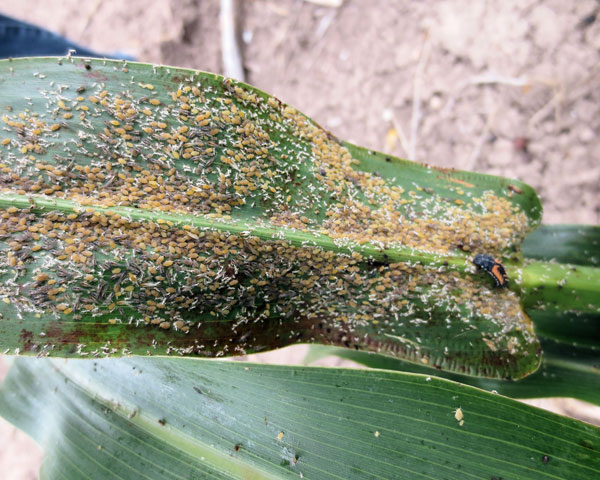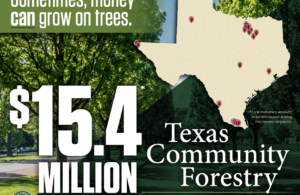- La Feria Native Soon To Retire From The Military This Summer
- Senior Eneece Avila Takes Pride in her State Title
- Dr. Noemi Infante, Harlingen Medical Center Open New Women’s Clinic
- Santa Rosa Cameron County Park Partially Reopens
- Santa Rosa Takes to Regionals Meet in Kingsville, Tx
- Long-Standing Nexstar Tower in La Feria Decommissioned
- Lionettes Powerlifting Meet
- Local Business Holds Event to Benefit RGV Shriners Club
- Knights of Columbus Holds it’s 30th Annual Golf Tournament
- KGBT Tower Dismantled
AgriLife Extension Sets Sugarcane Aphid Meeting in Weslaco
- Updated: April 15, 2016
by Rod Santa Ana/Texas A&M Agrilife
WESLACO — Rio Grande Valley growers vigilant for outbreaks of the sugarcane aphid on their young grain sorghum crops are urged to attend the upcoming Sugarcane Aphid Informative Meeting, organizers say.
Danielle Sekula-Ortiz, a Texas A&M AgriLife Extension Service integrated pest management agent in Weslaco, said the meeting begins with registration and a breakfast at 8 a.m. April 12. Talks begin at 8:30 and will conclude at noon.
The meeting will be held at the Texas A&M AgriLife Research and Extension Center at Weslaco, 2415 E. State Highway 83.
Sekula-Ortiz said growers have been diligent in keeping their grain sorghum fields free of weeds and volunteer sorghum plants where sugarcane aphid populations develop and spread to crops.
“Growers are really making sure their fields are clean this year, and that could be the reason that so far, sugarcane aphids have been hard to find,” she said.

Sugarcane aphids can be seen in excessive numbers on this volunteer sorghum leaf found recently near Donna. An informational meeting to help growers cope with possible outbreaks will be held April 12 in Weslaco. (AgriLife Extension photo by Danielle Sekula-Ortiz)
Thanks to a wet year in 2015, populations were also low, but 2014 was a hot, dry year when populations exploded, greatly reducing grain sorghum yields and quality, Sekula-Ortiz said. Growers also had a difficult time harvesting because the insects’ waste, called honeydew, gummed up harvesting machines.
“This year we are currently scouting 12 commercial fields throughout the three counties in the Rio Grande Valley that produce grain sorghum,” she said. “We’ve been looking for sugarcane aphids, but they are hard to find. We found a few in some johnsongrass in Cameron, Hidalgo and Willacy counties, but none so far in commercial sorghum.”
Sekula-Ortiz said she did come across volunteer sorghum in the Donna area and saw — for the first time this growing season — high sugarcane aphid counts, over 1,000 per leaf. But thanks to grower efforts to reduce host plants in and near their fields, she has seen only two fields with volunteer sorghum and very little johnsongrass.
Nearby Mexican grain sorghum growers are also reporting few issues with sugarcane aphids.
“So far, our neighbors to the south of us in San Fernando, Reynosa, Rio Bravo and Matamoros are not experiencing any trouble with the aphid,” she said. “That’s always good news because pests do not respect borders and could easily affect Valley acreage and spread even farther north. Hopefully, our situation will mimic our neighbors as we get later into the season.”
Sekula-Ortiz said the April 12 meeting will provide growers with very good information about how the sugarcane aphid is likely to affect this growing season.
Two hours of Texas Department of Agriculture continuing education units will be offered, one in general and one in integrated pest management. Spanish translation will also be provided.
Presentations and speakers for the meeting include:
— “Sugarcane Aphid: Its Phenology and Insecticide Choices for 2016 in South Texas,” Dr. Raul Villanueva, food crop entomologist, University of Kentucky Research and Education Center, Princeton, Kentucky; Sekula-Ortiz; and Gabriela Esparza Diaz, graduate student, AgriLife Extension, Weslaco.
— “Insecticides and Best Management Practices – South Texas,” Dr. Robert Bowling, AgriLife Extension entomologist, Corpus Christi.
— “Geospatial Analysis of Melanaphis sacchari,” Esparza Diaz.
— “Working Out the Mechanisms of Host Plant Resistance in Sorghum and Forage Sorghum to the Sugarcane Aphid,” Dr. Scott Armstrong, research entomologist, U.S. Department of Agriculture-Agricultural Research Service, Stillwater, Oklahoma.
— “Economic Impact of the Sugarcane Aphid Outbreak in South Texas,” Dr. Samuel Zapata, AgriLife Extension economist, Weslaco.
Sekula-Ortiz said of special interest to growers is the availability of insecticides should an outbreak occur.
“We have received no word yet on the status of sulfoxaflor, better known as Transform, which has provided very good control,” she said. “But we’ve applied for a section 18 emergency use permit from the U.S. Environmental Protection Agency and we’ll pass along any word of that as soon as I get it.”
Another product available and labeled for use in grain sorghum that shows good control of the sugarcane aphid is the flupyradifurone, or Sivanto, Sekula-Ortiz said.
“We’ll be discussing all those insecticide issues and much more, so I urge growers to attend,” she said.
For more information, contact Sekula-Ortiz at 956-968-5581 or the AgriLife Extension office in Hidalgo, Cameron or Willacy counties.






